NickD said:
Every time I see this all I can think is it is a very imposing locomotive!
NYO&W FTs hurrying past the disused switch tower at Campbell Hall, NY in the late '40s. In addition to dieselization, the NYO&W was an early implementer of Centralized Traffic Control in an attempt to cut costs and streamline operation.
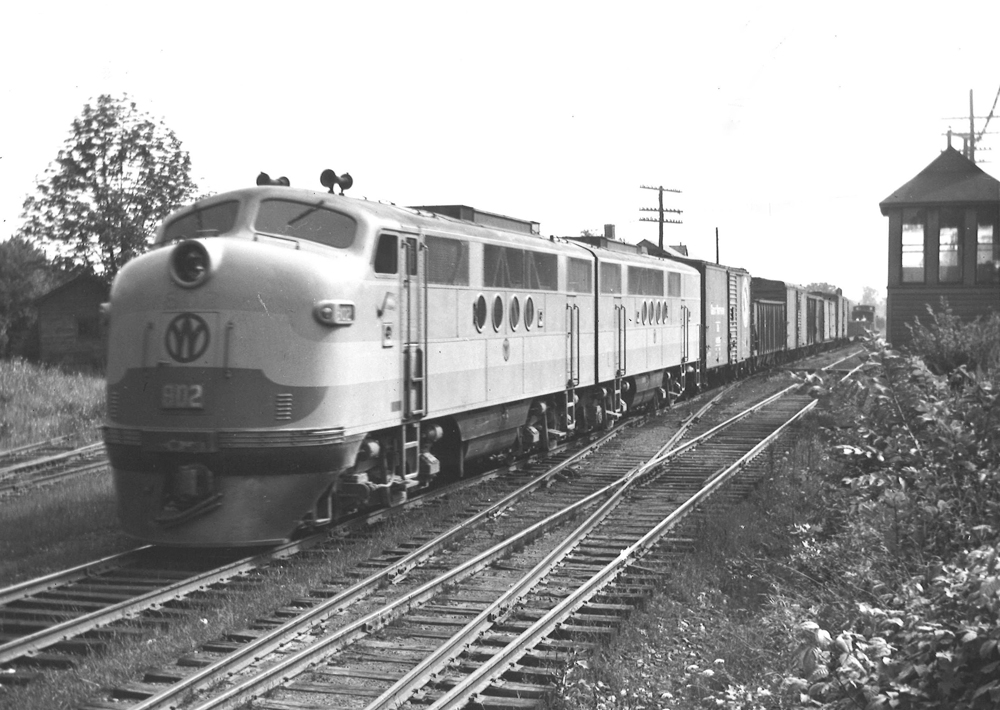
One of the NYO&W's near "Light 400" Class Y Mountains crosses the Delaware River at Hancock, NY with symbol freight SU-1 (Scranton-Utica). Seventy-eight cars back, a Class X "Bullmoose" is shoving hard on the back of the train.
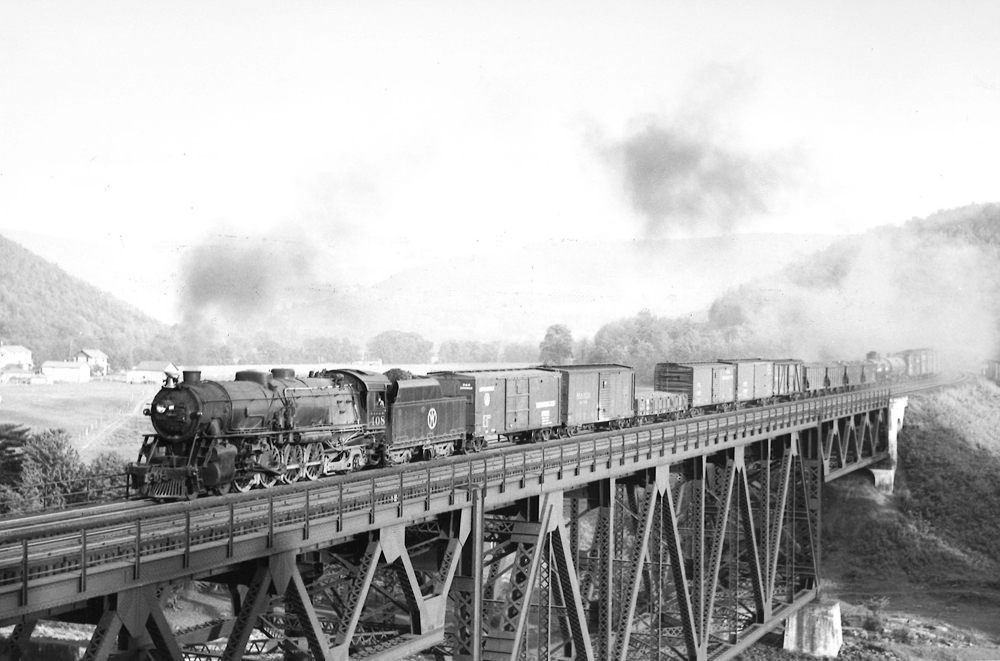
One of the much-maligned Class X 2-10-2s leads symbol freight US-2 (Utica-Scranton) at Preston Park, Pa, with a Consolidation shoving on the rear. In addition to it's torturous routing, multiple light bridges, and small tunnels, the NYO&W mainline also possessed no less than 6 helper districts and the highest speed sections were a mild 40mph. Small wonder that shippers preferred it's faster, more efficient competitors.
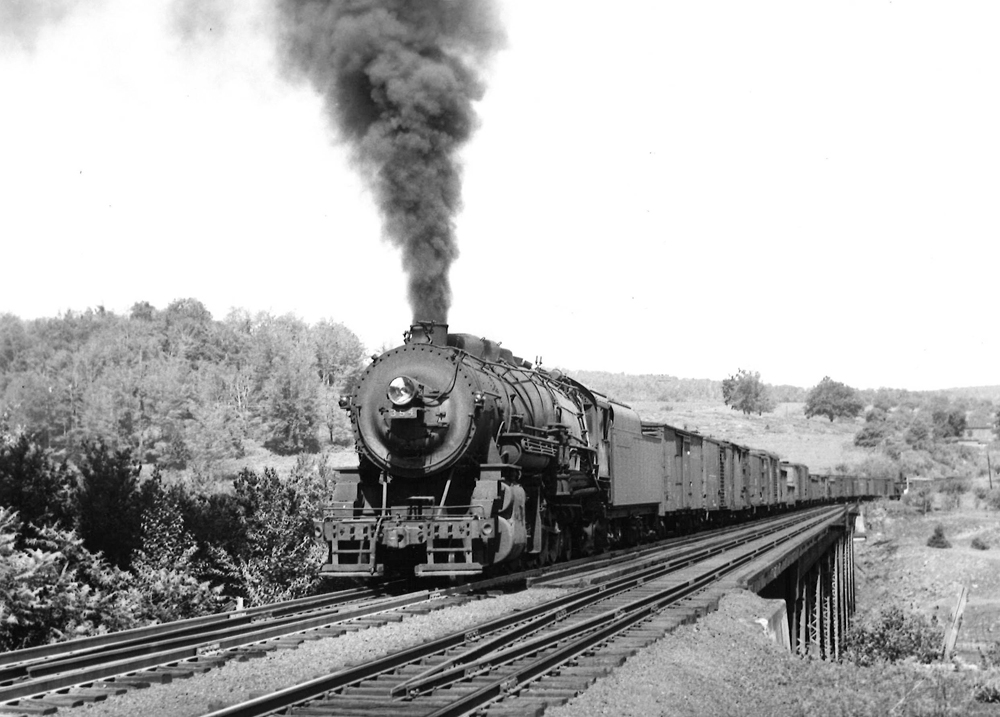
An exact duplicate of a New York Central L-2 Mohawk, the NYO&W Y-2 "Big 400s" were the newest, and finest, locomotives owned by the railroad. Testament to the rough grades and curves of the NYO&W is the helper locomotive cut in 16 car back,.
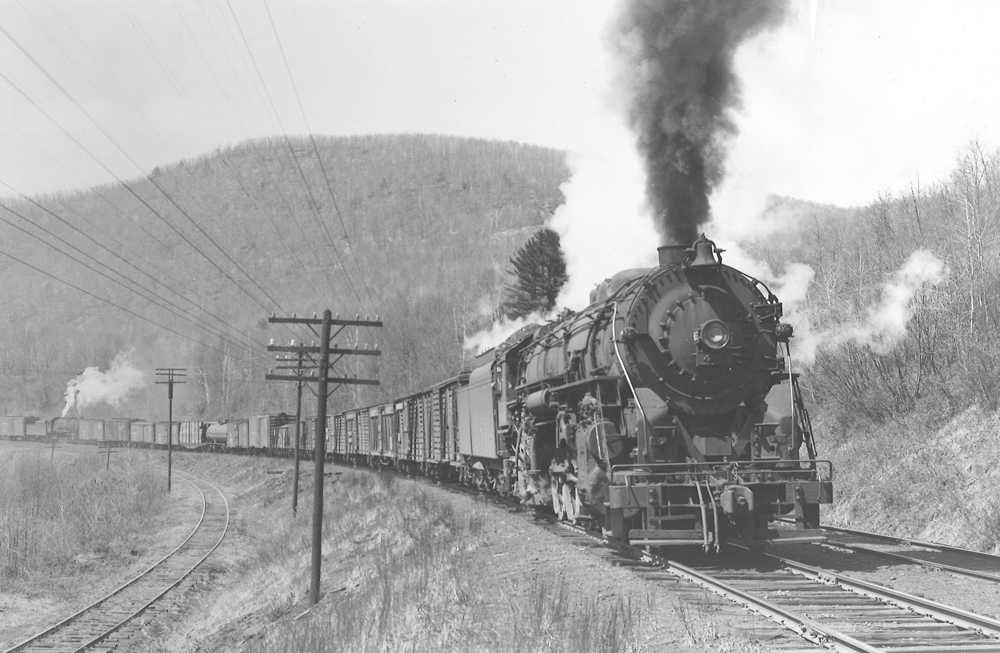
A Class I rear-cab Mogul, a 1904 Cooke product, leads what appears to be a mixed train out of Rome, NY.
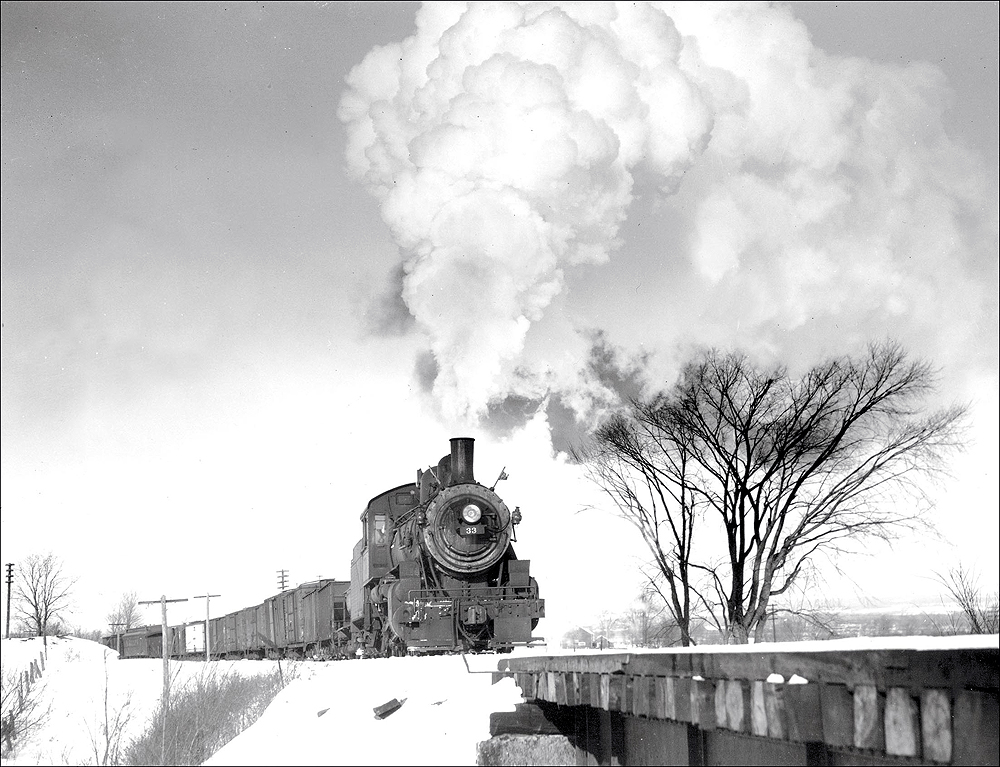
The NYO&W was doomed from the day it was born, really. The major impetus for construction of the New York & Oswego Midland, as it was originally chartered in 1868, was that Oswego was speculated to continue its growth as a major deepwater port for Lake Ontario. By connecting the Port of Oswego to the Hudson Bay at Weehawken, NJ, the plan was to capitalize on bridge traffic between the two waterways. To help fund construction, the NY&OM took advantage of the Town Bonding Act, which allowed towns to subscribe to bonds and in return the railroad would build through their town. Unfortunately, the NY&OM was Johnny-come-lately to New York, which had the New York Central & Hudson River, the West Shore, and others already sprawled everywhere, most of the major cities refused to subscribe to the bonds because they didn't need another railroad. This left the NY&OM having a number of tiny nowhere towns subscribe to the bonds, which resulted in unfortunate routings like around the north side of Oneida Lake where there "wasn't enough population to raise an umbrella". Not helping the situation was president Dewitt Clinton Littlejohn's decision to build as-the-crow-flies, rather than following the contour of the land. He accomplished in building a short route to nowhere, at the expense of many steep grades, high fills, long trestles, and tunnels, all of which were expensive to build and maintain. Within a month of beginning operation, the NY&OM went bankrupt due to excessive construction costs, and was reorganized as the NYO&W.
The main reason for construction, the Port Of Oswego, never panned out. The port began a decline in 1874, overshadowed by ports at Toronto, Ontario, and Niagara, and the Great Lakes traffic was never what it was hoped it would be. Instead, the NYO&W entered a partnership with the New York, West Shore & Buffalo to try and compete against the New York Central & Hudson River. The NYC&HR viewed it as a nuisance or blackmail threat and bankrupted the West Shore, which dissolved the partnership. The NYO&W ended up subsisting on profits from transporting milk down to New York City, as well as lots of passenger traffic from New York City and New Jersey up to vacations in the Borscht Belt.
Robert Fowler took over the NYO&W in the late 1880s, and was noted to have remarked that the railroad should never have been built and wondering why after it had gone bankrupt it hadn't been allowed to remain there. Despite his disapproving remarks of his charge, Fowler expanded the dairy operations, capitalized on the passenger traffic with all sorts of special trains (summer "camp specials" often ran with three or four sections north from the city), and oversaw the construction of the Scranton Division to get into hauling anthracite. The Rome & Clinton Railroad and the Utica, Clinton & Binghamton Railroad were both purchased to give the O&W access to Utica and Rome. They were fat, happy times for the NYO&W, despite it's also-ran status, and it paid stock dividends into the Great Depression.
It was purchased by the New York, New Haven & Hartford in 1904, in an attempt to take over the New England railroad markets, but Charles Mellen largely tried to use the NYO&W as a bargaining chip with the New York Central, which resulted in the NYO&W having minimal investment into it's infrastructure. Then 1911 saw an attempt by the New York Central to take over the NYO&W, partially because it valued it's route from Fulton to Oswego, but also because the New York Central wanted no competition in "it's" state. The attempt failed though, due to antitrust laws. Then in the '30s, the automobile eroded away the dairy contracts. The automobile and the invention of air conditioning whittled away at the popularity of the Catskills, and took it's passenger traffic with it. The O&W was hauling just 4% of Pennsylvania anthracite, but it was making up 50% of the railroad's profits, and as petroleum and natural gas began to gain favor for heating and the anthracite mines played out or went bankrupt, the O&W's fortunes went with them. Manufacturing began to move from the Northeast to the South and West, taking away more of its customers. It filed bankruptcy in 1937, and never really recovered. Diesels, Centralized Traffic Control, and an attempt at rebranding itself as a bridge line all failed to turn things around, as it was still viewed as inefficient, poorly-routed, rundown, and antiquated. Passenger service to the Catskills ended in '48 and system-wide in '53.
The New Haven reentered the scene in '52, with intentions of buying the NYO&W again, but the New Haven was having its own financial troubles as well and backed out of the deal. As bankruptcy proceedings continued, local communities screamed bloody murder over the possibility of abandonment, as the O&W owed them years of back taxes. The New York State legislature approved a $1 million aid bill, laughably citing the O&W as essential for civil defense, but the state civil defense commission rejected it. By March 29th, 1957, the bankruptcy court ordered completely abandonment of the railroad. Three scrap dealers purchased the majority of the right of way and yanked it up in 1958. The DL&W grabbed a portion from Utica, NY to New Hartford, NY (still is use with the NYS&W's Utica Branch), the New York Central grabbed the entire mainline from Fulton to Oswego (still in use by CSX) and the Erie purchased some pieces down in New Jersey. The switchers were sold off to various new owners, the F-units were largely split between Erie and NYC for trade-ins (although two F3s went and served the Western Pacific), and the majority of freight cars and passenger cars were so rundown that they were cut up on the spot.
Wrote A.V. Neusser and C.E. Pearce, in the August 1942 issue of Trains Magazine: "This road really starts nowhere, goes nowhere, avoids all large industrial centers, and ends nowhere." But it did so with charm.
Only a ten minute stop, but the coffee was hot
Mountaindale, Liberty, Roscoe, Young's Gap we once topped
Oh, teakettle, teakettle, we yearn to hear your bell
High View tunnel, your dark passage we knew so well
Now the rails are gone, oh, old friend we miss the days
When a headlight and whistle led our way
The coffee in Middletown no longer brews
To the call of "All aboard!!", The whistle no longer wails.
For thousands of vacationers heading to the mountains by rail.
I have considered, if I were to get into model railroading, doing a fictitious version of what the NYO&W would have looked like if business hadn't taken such a drastic downturn and the NYO&W had survived into, say, the mid-1960s. Since they were a big EMD purchaser, GP7s and/or GP9s (perhaps "torpedo tubes" to replace the steam heater cars built from Bullmoose tenders that they towed behind their FTs/F3s) seem like an obvious choice, although with the stiff grades, they might have gone with SD7s or SD9s for the added tractive effort. The Quebec, North Shore & Labrador actually ordered GP7s that used the NYO&W paint scheme, sans the O-in-W herald, so I have an idea of what they would have looked like.

GP30s also seem like they would be cool in those color and not that far-fetched of a purchase. The NYO&W's only non-EMD diesels were a batch of GE 44-tonners, but they also purchased all their steam locomotives from Alco (or it's related predecessors like Brooks and Dickson and Cooke), so I could see them possible ordering some RS-3s or RS-11s or RSD-12s or C420s. I think Baldwin or F-M products would be stretching it a bit too far.
DjGreggieP said:NickD said:
Every time I see this all I can think is it is a very imposing locomotive!
It's too bad that almost all of the big drag-freight Mallets didn't escape the cutting torch. Pretty much just the two C&O H-6s and the N&W Y3 and Y6a. All of the UP 2-8-8-0s, KCS 2-8-8-0s, N&W Z-1 2-6-6-2s, D&RGW 2-8-8-2s, Great Northern R-2 2-8-8-2s, and B&O's many, many flavors of Mallets. B&O invented the articulated locomotive and they had 0-6-6-0s, 2-6-6-2s, 0-8-8-0s, 2-8-8-0s, and 2-8-8-2s, as well as single-expansion 2-6-6-4s and 2-8-8-4s. Probably my favorite Mallets were the neat little 2-6-6-0s that the Denver & Salt Lake had.

Probably the best-looking articulated locomotives were the Baltimore & Ohio's EM-1 2-8-8-4s. Ironically, the B&O didn't even originally want the EM-1s. They wanted diesel locomotives, but since it was 1944, the War Production Board had diesel engine production locked down, although by this point they had relaxed their mandate for using existing steam locomotive designs. So Baldwin cooked up a very nice, modern Yellowstone for the B&O. While they were the biggest engines owned by the B&O, they were the smallest 2-8-8-4s built in the US. With lateral motion devices on each lead driver axle and the lead axle in the trailing truck, roller bearings on every single axle, and 64" drivers, they proved themselves to be powerful, reliable, and surprisingly fast, even seeing occasional duty on passenger trains. They were also just a good looking engine, very aesthetically balanced.

In reply to NickD :
I saw a railfan with his camera setup down the street today & thought maybe they'd finally resumed Amtrak service here. Sadly no, but the train did have 3 locomotives on the head, which is pretty unusual since they introduced distributed power.
In reply to Pete Gossett (Forum Supporter) :
Unfortunately, it doesn't sound like Gulf Coast service will be returning too soon. It's bogged down in a huge argument with CSX, NS and Port of Mobile on one side, and Amtrak and the federal government on the other side, with the STB caught in the middle. CSX is saying that since Gulf Coast service was rudely interrupted in 2005, freight traffic on their portion of the line has increased so much that they don't have any capacity to squeeze two daily Amtrak trains in. CSX is saying that if Amtrak wants to run service on that line, Amtrak is going to have to pay for capacity upgrades on the line, while Amtrak is saying that they are not responsible for upgrades and improvements to lines that they don't own. Port of Mobile says they don't care who pays for what, but that service cannot be interrupted. And NS just kind of seems to be standing with CSX out of solidarity. Amtrak is saying that CSX and NS are slow-rolling the process and is asking the STB to force the freight lines to allow them to operate over them, which would be an unprecedented move and set a dangerous trend. I get that Amtrak wants to start service again, but if it causes a complete traffic jam along the Gulf Coast, that isn't doing anyone any good. CSX, NS, and Port Of Mobile are requesting that the STB appoint a third-party mediator to try and resolve the conflict and come up with some sort of compromise.
https://railfan.com/csx-ns-ask-for-mediation-on-gulf-coast-dispute-with-amtrak/
In reply to NickD :
Intriguing, I'd not heard any of that but it certainly explains the delay.
I'm not sure I buy the argument about freight traffic though. On a busy day we might have a half-dozen trains pass the house. Often there's less.
In reply to Pete Gossett (Forum Supporter) :
I know NS was pointing the finger at Amtrak, saying that a joint traffic impact study had to be done, and NS was saying Amtrak stepped away and never did their part of the study.
The three railroads typically considered the kings of articulated locomotives are Union Pacific for those famous Challengers and Big Boys, Norfolk & Western for those perfected Y6bs and As, and Chesapeake & Ohio for those many 2-6-6-2s and 2-8-8-2s and those unmatched Alleghenies. But worthy of consideration is The Big G, Great Northern, who built some owned and built some truly heroic machines for dragging tonnage through the Cascades.

Witness the Great Northern R-2 class 2-8-8-2. Constructed at the GN's own Hillyard Shops in Spokane, Washington, these were the largest steam locomotives constructed west of the Mississippi. A boiler tube pilot, air pumps hung out on the smokebox front, that square-shouldered Belpaire firebox that GN was as fond of as the PRR, a raked-forward cab with streamlined faring for the ladder aboved a Delta trailing truck, a big Vanderbilt tender, and graphited smokebox with a dark green boiler jacket and dark red cab roof, they were uniquely GN and a fierce-looking machine. With 63" drivers, a 240psi boiler, 28"x32" cylinders, and 126 square feet of great area, they cranked out an ungodly 162,475lbs of tractive effort. That's over 32,000lbs more than a Union Pacific Big Boy and just 7,500lbs less than a Norfolk & Western Y6b. A truly monstrous machine.
Joe Collias recounts in The Last Of Steam that by 1956, the era of steam was pretty much over for Great Northern, with all the articulateds retired and in storage, and just a few of their big Mikados were still on the job. A traffic surge though forced the reactivation of a single R-2, #2053, between between Grand Forks and Devil's Lake. Run hard to the end, and then stored without any care for years, the #2053 was in pretty dilapidated condition. As little was done to return it to operation as possible, knowing that it wasn't going to have to live long, and the engine house foremen at each end of the division did as little mechanically as possible to the behemoth, and then sent her back on her way to the other division point in hopes that it wouldn't return. The engineer assigned was described by Collias as a "young thuggish type with a flattop haircut" and he was either extremely proud of his charge or was trying to kill it off as soon as possible so that he could get assigned to a diesel, because he would come tearing by at 50mph with 145 cars tied to the back of the tender, steam leaks everywhere, running gear clattering, the whole affair looking and sounding like it was about to come off the rails. He surmised that she stayed alive mainly through her own determination to remain in steam.
GN also had some 2-8-8-0s that were unholy terrors. They were delivered as class N-1 by Baldwin in 1912, with an engine weight of 450,000lbs. They were a compound articulated locomotive with unusually tall 63" drivers, 28"x32" high pressure cylinders, 42"x32" low pressure cylinders, a 210psi boiler with a Belpaire-style rear course, 78.4 square feet of grate area, 98,422lbs of tractive effort, and a 4.27 factor of adhesion. They were also built as oil-burning engines, some of the first for GN, with numerous other locomotives being converted from coal to oil by GN at the same time in light of forest fires in Washington caused by coal cinders. They were the tallest locomotives on the Great Northern, because, without a trailing truck under it, they had to fit a sufficiently sized firebox above the drive wheels. Of particular interest is that in documentation Baldwin sent to GN was the warning to "give particular attention to riveting of cylinder saddles and caulking of same." Leaky seams forced the railroad to remove lagging from all the boilers in the first batch save that of #2016 and caulk them. A least some high-pressure cylinders leaked and the flexible stay bolts at the back end of the combustion chamber either required redesign or at least more stays. But, that issue aside, the N-1s were a powerful engine, although their low speed compound nature failed to take advantage of the 63" drivers.
In 1924, Great Northern began a rebuilding program of all 25 of the N-1s. The biggest change was that they were converted to single-expansion "simple" articulateds, with four 25"x32" cylinders. They also added a Worthington feedwater heater, and a combustion chamber to the firebox, adding another 23 square feet of firebox area, as well as reduced the number of tubes but added more superheater flues. Engine weight, driver diameter, firebox grate area, and boiler pressure all remained unchanged. The changes resulted in 113,330lbs of tractive effort and an engine better able to take advantage of the 63" drivers it was equipped with, although the factor of adhesion went from a slightly inefficient 4.27 to a slightly slippery 3.71. This rebuild changed their class to N-2.
Then, in 1940, Great Northern sent all the N-2s through the shops again. This time, they received some pretty massive changes. They had a new cast-steel bed frame provided by General Steel Castings, and an all-new nickel-steel boiler provided by Baldwin. There was also a larger firebox, with another 17 square feet of grate area and another 76 square feet of firebox area from added arch tubes. Boiler pressure shot up to 275psi, an increase of 65psi, although a reduction in cylinder diameter of 3" meant this didn't result in a massive increase in power, rated at 114,931lbs of tractive effort. Factor of adhesion did become a perfect 4.0 though, making them more sure-footed than the N-2s and more efficient than the N-1s. Engine weight shot up by almost 40,000lbs, tipping the scales at 489,000lbs for the locomotive. Timken roller bearings were also applied to all the drive axles. The first of the rebuilds was completed on February 10th, 1940, and the the last was wrapped up almost exactly two years later on February 12th, 1942. The timing couldn't have been better, since these N-3s were rolling out as near-new locomotives just in time for WWII. And did the N-3s ever deliver, according to Charles R. Wood. He described them as: "Amazing engines, they hauled ore on the iron range, hustled time freights on the Kalispell Division and served in heavy duty passenger service on troop trains." On the latter service, Wood quotes Mr. J S Miller, Assistant to the Superintendent of Motive Power in 1945-46 as saying that N-3s could "...run like a deer" and hit speeds of 50-60 mph.

A color photo of an N-3 at Spokane, showing the Glacier Green boiler jacketing, black running gear, and graphited smokebox that GN applied to them.
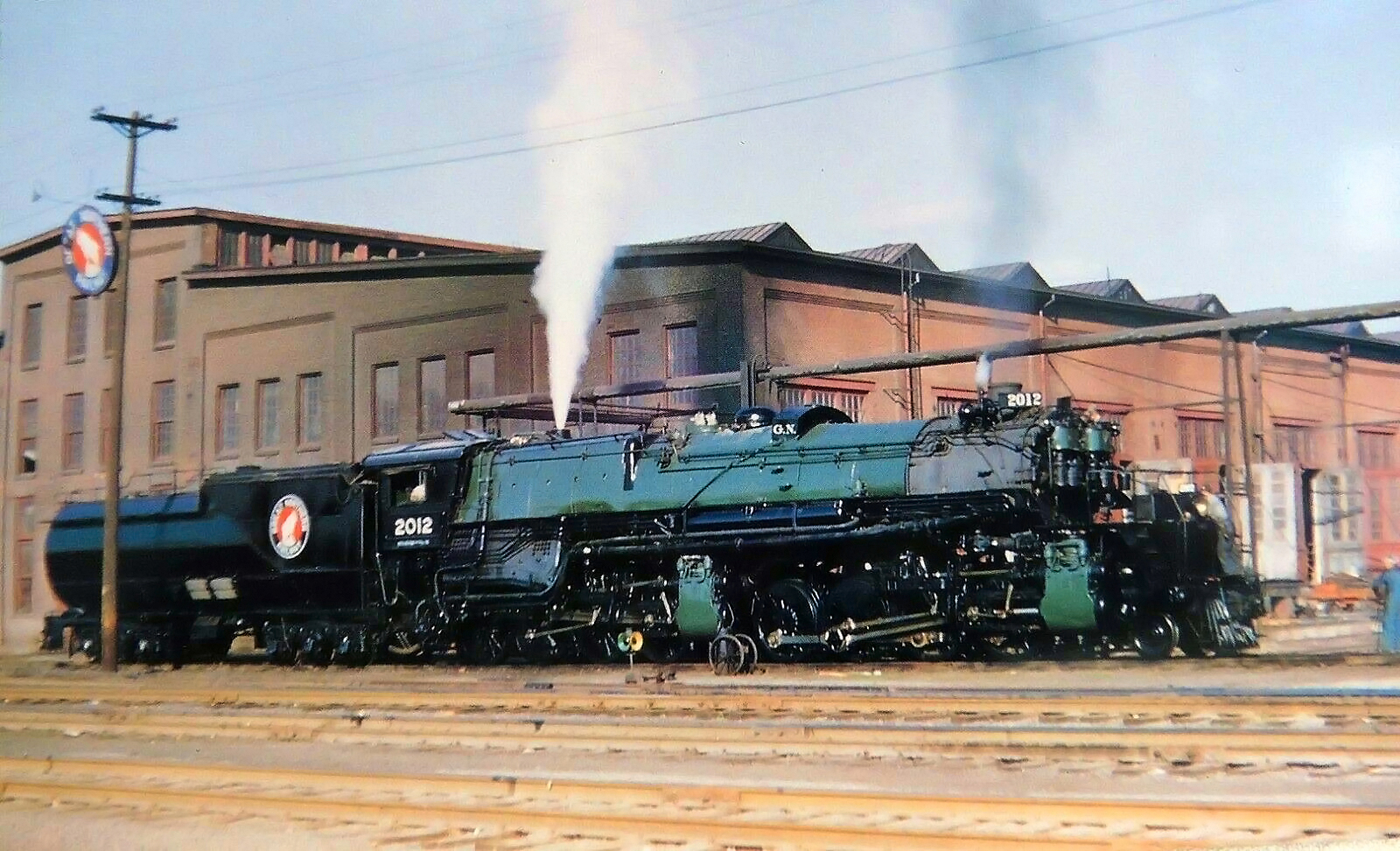
Everything you always wanted to know about ACCA Yard, Richmond, VA.
https://www.railfanguides.us/va/richmond/map2/index.htm
http://www.csxaccayard.nlms.info/chapters/history/acca.htm

NickD said:In reply to Pete Gossett (Forum Supporter) :
I know NS was pointing the finger at Amtrak, saying that a joint traffic impact study had to be done, and NS was saying Amtrak stepped away and never did their part of the study.
I'm guessing that's due to Amtrak needing to access NS trackage in Mobile?
You'll need to log in to post.